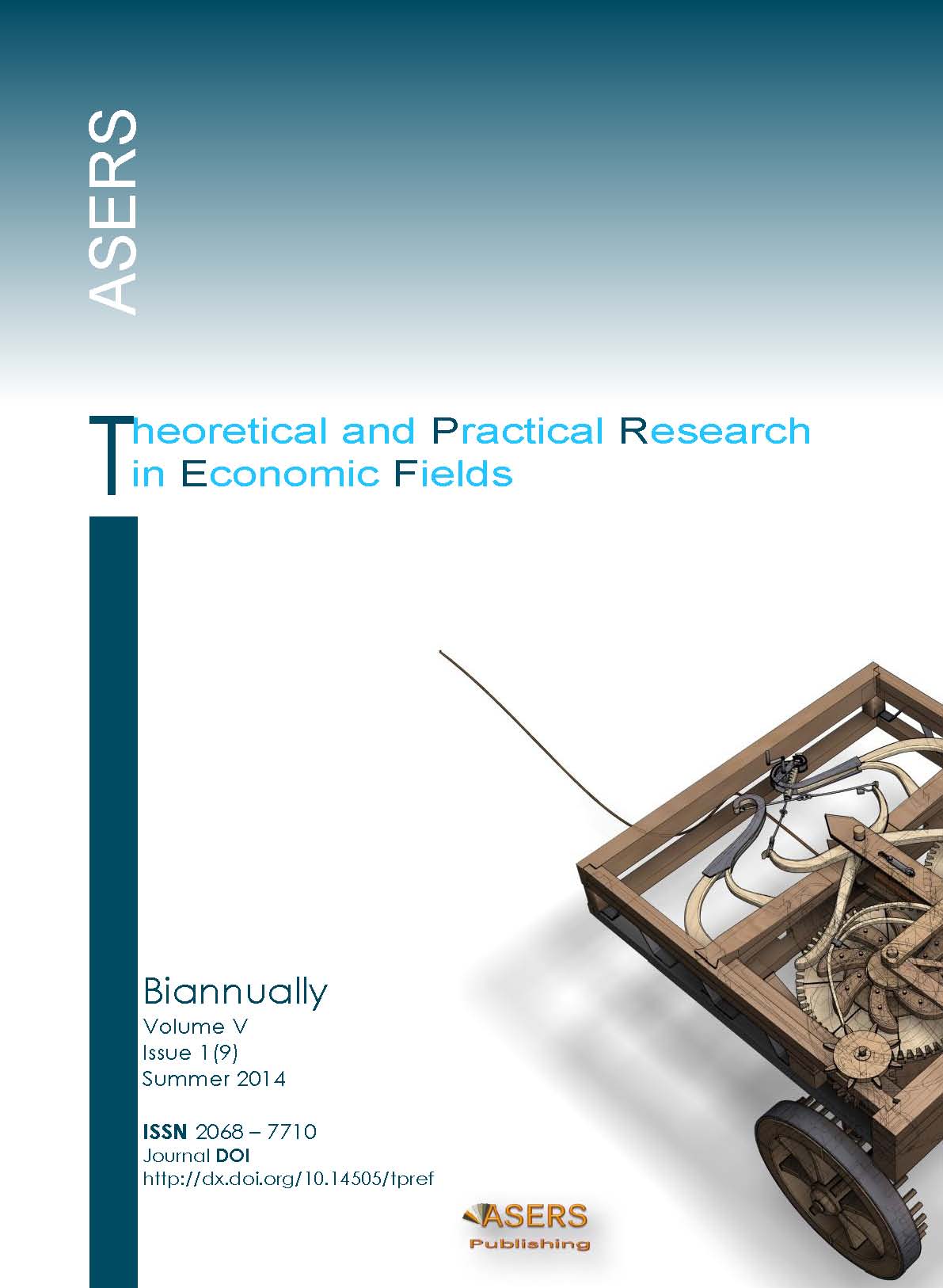HOW BIG ARE THE EMPLOYMENT EFFECTS OF MICROLOANS? EVIDENCE FROM A CASE STUDY IN LATVIA
Abstract
Microloans to small and medium-sized enterprises have become popular in many countries. However, evidence on the economic and social impact of microfinance is scarce. In an attempt to partly fill this gap, this paper looks at a case study and analyzes the economic impacts of the microloan programme of the Latvian development bank Hipoteku Banka. In our analysis, we focus on the following questions: Did the microloan programme increase employment within the supported firms? And was it able to contribute to the economic development of rural areas and the decrease of economic inequalities across regions? We find that the firms that were granted a loan from Hipoteku Banka on average considerably increased their employment during the loan period, as well as the microloan programme made a successful contribution to the economic development of rural regions in Latvia.
References
[2] Armendáriz, B., Morduch, J (2010). The Economics of Microfinance, MIT Press, 2nd Edition, Massachusets.
[3] Baldi, G. (2013). Physical and Human Capital Accumulation and the Evolution of Income and Inequality, Journal of Economic Development, 38(3): 57-83.
[4] Banerjee, A., Duflo, E. (2009). The Experimental Approach to Development Economics, Annual Review of Economics, Annual Reviews, 1(1): 151-178.
[5] Bateman, M., Chang, H-J. (2013). The Microfinance Illusion. Available at: http://www.econ.cam.ac.uk/ faculty/chang/pubs/Microfinance.pdf
[6] Bateman, M. (2010). Why Doesn't Microfinance Work? The Destructive Rise of Local Neoliberalism. Zed Books Ltd, London.
[7] Beck, T., Demirguc-Kunt, A., Levine, R. (2005). SMEs, Growth, and Poverty: Cross-Country Evidence. Journal of Economic Growth, 10(3): 199-229.
[8] Beck, T., Demirguc-Kunt A., Honohan, P. (2009). Access to Financial Services: Measurement, Impact, and Policies. World Bank Research Observer, Oxford University Press, 24(1): 119-145.
[9] Bendig, M., Unterberg, M., Sarpong, B. (2012). European Microfinance Network 2010-2011. Overview of the Microcredit Sector in the European Union. Available at: http://www.european-microfinance.org/data/file/ overview2010-2011-final.pdf
[10] Brown, A. (2013). 5 Lessons in Microfinance from Eastern Europe. Available at: http://europe. microfinancefocus.com/5-lessons-in-microfinance-from-eastern-europe/
[11] Komisare, L. (2013). “Capitalia” pirmie Baltijas valstīs iziet uzņēmumu mikrokreditēšanas apmācības kursu, saņemot atbalstu no Eiropas Investīciju fonda. Available at: http://www.nozare.lv/nozares/ fin/item/2013010314200002EED306B7C47C0B2A/?phase=mikrokredit%C4%93%C5%A1ana
[12] Cull, R., Demirguc-Kunt, A., Morduch, J. (2009a). Banks and Microbanks. Policy Research Working Paper, Series 5078, The World Bank.
[13] Cull, R., Demirguc-Kunt, A., orduch, J. (2009b). Microfinance tradeoffs: regulation, competition, and financing, Policy Research Working Paper Series 5086, The World Bank.
[14] De Soto, H. (2000). The Mystery of Capital: Why Capitalism Triumphs in the West and Fails Everywhere Else. Basic Books, 1st edition.
[15] Eriksson, P-E, Krämer-Eis, H., Conforti A. (2011). Microfinance in Europe, in: APS Bank Occasional Papers, 10: 49-86.
[16] Guiso, L., Sapienza P., Zingales, L. (2004). Does Local Financial Development Matter? The Quarterly Journal of Economics, 119(3): 929-969.
[17] King, R., Levine, R. (1993). Finance and Growth: Schumpeter Might Be Right. The Quarterly Journal of Economics, 108(3): 717-37.
[18] Loncar, D., Novac, C., Cicmil, S. (2013). Global recession and sustainable development: the case of microfinance industry in Eastern Europe. Available at: http://www.microfinancegateway. org/gm/document-1.9.39138/MICROFINANCE%20PAPER-%20FINAL%20VERSION.pdf
[19] Vanroose, A., D’Espallier, B. (2013). Do microfinance institutions accomplish their mission? Evidence from the relationship between traditional financial sector development and microfinance institutions’ outreach and performance. Applied Economics, 45(15): 1965-1982.
[20] Vento, G. (2011). Recent Trends in Microfinance Industry: Regulation, Supervision, and the Principles of the Basel Committee. In: Microfinance Regulations for Development: Global Experiences (eds. I. Rahman and L. Rashid), The University Press Ltd.
*** Bank for International Settlements (BIS) (2010). Microfinance activities and the Core Principles for Effective Banking Supervision. Basel, August 2010.
*** BNS (2011). Pētījums: mikrokreditēšana Latvijā līdz šim nav uzskatīta par būtisku atbalsta instrumentu uzņēmējdarbības veicināšanai. Available: http://news.lv/BNS/2011/03/24/Petijums-mikrokreditesana-Latvija-lidz-sim-nav-uzskatita-par-butisku-atbalsta-instrumentu-uznemejdarbibas-veicinasanai
*** Central Statistical Bureau of Latvia (2013). Gross Domestic Product by Statistical region, City and District (NACE Rev.2). Available at: http://data.csb.gov.lv/Dialog/varval.asp?ma=IK0021a&ti=IKG021.+GROSS+DOMESTIC+PRODUCT+BY+STATISTICAL+REGION%2C+CITY+AND+DISTRICT+%28NACE++Rev.2%29&path=../DATABASEEN/ekfin/Annual%20statistical%20data/02.%20Gross%20domestic%20product/&lang=1
*** Central Statistical Bureau of Latvia (2013). Population by Labour Status and Statistical Region. Available at: http://data.csb.gov.lv/Dialog/varval.asp?ma=NB0030a&ti=NBG03.+POPULATION+BY+LABOUR+STATUS+AND+STATISTICAL+REGION&path=../DATABASEEN/Iedzsoc/Annual%20statistical%20data/05.%20Employment%20and%20unemployment/&lang=1
*** CGAP and MIX (2010). Eastern Europe and Central Asia Microfinance Analysis and Benchmarking Report 2010, Washington.
*** Eiropas Komisija (2013). Mikrofinansēšanas instruments. Available at: http://ec.europa.eu/social/main.jsp? langId=lv&catId=836
*** European Commission (2010). Gaining Scale in Microcredit: Can Banks Make it Happen? Luxembourg.
*** Florida State University. Department of Urban and Regional Planning. Planning Methods III: Forecasting (2013) Location Quotient Technique. Available at: http://mailer.fsu.edu/~tchapin/garnet-tchapin/urp5261/ topics/econbase/lq.htm
*** Hipotēku Banka (2006). Jauna, kompleksa ALTUM apmācību un atbalsta programma cilvēkiem, kuri vēlas uzsākt savu biznesu. Available at: http://www.hipo.lv/lv/par_banku/ jaunumi/jauna_kompleksa_altum_ apmacibu_un_atbalsta_programma_cilvekiem_kuri_velas_uzsakt_savu_biznesu
*** Hipotēku Banka (2013). Mikrokreditēšanas programma. Available at: http://www.hipo.lv/lv/attistibas_ programmas/mikrokreditesanas_programma
*** Ministru Kabinets (2009). Koncepcija par mikrouzņēmumu atbalsta pasākumiem. Available at: http://polsis.mk.gov.lv/view.do?id=3219
Non-Exclusive License under Attribution 4.0 International Public License (CC BY 4.0):
This ‘Article’ is distributed under the terms of the license CC-BY 4.0., which lets others distribute, remix, adapt, and build upon this article, even commercially, as long as they credit this article for the original creation. ASERS Publishing will be acknowledged as the first publisher of the Article and a link to the appropriate bibliographic citation (authors, article title, volume issue, page numbers, DOI, and the link to the Published Article on ASERS Publishing’ Platform) must be maintained.
